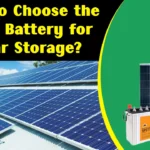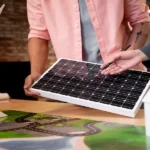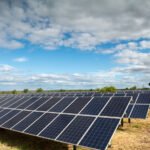Solar energy is growing fast in India. Many people are installing solar panels in homes, offices, and industries. But when you talk to solar experts, you may hear words that sound technical or confusing. Understanding these terms will help you make better decisions when buying, installing, or maintaining a solar system.
Here is a detailed solar glossary with 25 important terms explained in simple English so anyone can understand them.

1. Solar PV (Photovoltaic)
Solar PV means using sunlight to create electricity directly through solar cells. These cells are usually made of silicon. When sunlight hits them, it creates an electric current. This is the technology used in most rooftop solar systems in India.
2. Solar Thermal
This system uses sunlight to heat water or air instead of making electricity. Solar water heaters are the most common example. They are popular in Indian homes, hotels, and industries to save electricity costs.
3. Solar Panel (Module)
A solar panel is a group of solar cells connected together to produce electricity. Panels are placed on rooftops or open spaces to capture sunlight.
4. Solar Array
When many solar panels are connected together, it forms a solar array. The bigger the array, the more power it can produce.
5. Watt (W)
The watt is a unit of power. It shows how much energy is being produced or used at one moment. For example, a 300-watt solar panel can produce 300 watts of power under ideal sunlight.
6. Kilowatt (kW)
1 kilowatt equals 1,000 watts. Solar systems are often measured in kilowatts. For example, a 5 kW rooftop system can power a medium-sized Indian home.
7. Kilowatt-Hour (kWh)
This is a unit of energy. It means using 1,000 watts for one hour. Electricity bills in India are calculated in kWh (also called “units”).
8. DC (Direct Current)
Solar panels produce DC electricity, which flows in one direction. But most home appliances in India use AC electricity, so an inverter is needed.
9. AC (Alternating Current)
AC electricity changes direction many times a second. This is the type of electricity supplied by the power grid in India.
10. Inverter
An inverter converts DC electricity from solar panels into AC electricity for home or business use. It is a critical part of any solar power system.
11. On-Grid Solar System
This system is connected to the government electricity grid. If your solar panels make extra power, it can be sent to the grid. You get credits on your bill through net metering.
12. Off-Grid Solar System
This system works without a grid connection. It uses batteries to store electricity for use at night or during power cuts. Common in remote villages in India.
13. Hybrid Solar System
A hybrid system combines on-grid and off-grid benefits. It connects to the grid but also has batteries for backup power.
14. Net Metering
A billing system where extra electricity you send to the grid reduces your electricity bill. Many Indian states support net metering policies.
15. Feed-in Tariff (FiT)
This is the price you get paid for selling extra solar electricity to the grid. Rates vary by state in India.
16. Solar Tracking System
A device that moves solar panels to follow the sun during the day. This increases energy generation but also costs more.
17. Tilt Angle
The angle at which solar panels are installed to capture the maximum sunlight. In India, the ideal tilt depends on your location’s latitude.
18. Peak Sun Hours
The average number of hours per day when sunlight is strong enough for solar panels to produce power. In most parts of India, it’s about 4–6 hours daily.
19. Solar Efficiency
This tells how much sunlight a solar panel can convert into electricity. Higher efficiency panels cost more but produce more power in the same space.
20. Monocrystalline Panels
Made from a single crystal of silicon. They are more efficient and last longer, but cost more. Common in premium rooftop solar systems in India.
21. Polycrystalline Panels
Made from multiple crystals of silicon. They are slightly less efficient but more affordable, popular for budget-friendly solar projects.
22. Thin-Film Panels
Lightweight panels made from different materials like cadmium telluride. They are less efficient but work well in certain large-scale projects.
23. Solar Charge Controller
A device that controls how much electricity goes into the batteries. It prevents overcharging and extends battery life.
24. Battery Bank
A group of batteries connected together to store solar energy for later use. Common in off-grid and hybrid systems.
25. Levelized Cost of Energy (LCOE)
A way to measure the total cost of solar energy over its lifetime. It includes installation, maintenance, and other costs.
Also Read Solar Feasibility Study in India: Complete Step-by-Step Guide for Maximum Returns
Why Knowing These Terms is Important for Indian Solar Buyers
Understanding these terms will help you talk to solar installers confidently. You will know whether they are offering you the right system for your needs. It will also help you compare prices, understand government incentives, and check warranty details.
FAQs on Solar Energy Terms in India
Q1. Which solar term is most important for homeowners?
For most homeowners, understanding kW, kWh, inverter, and net metering is most useful. These terms affect your bill savings directly.
Q2. Are monocrystalline panels better for Indian weather?
Yes. They perform better in low light and high temperatures, but they are more expensive.
Q3. What is the lifespan of solar panels in India?
Most panels last 25 years or more with proper maintenance.
Q4. Does net metering work everywhere in India?
No. Each state has its own net metering policy. You must check with your state electricity board.
Q5. How much efficiency do solar panels lose over time?
On average, solar panels lose about 0.5% efficiency per year.










